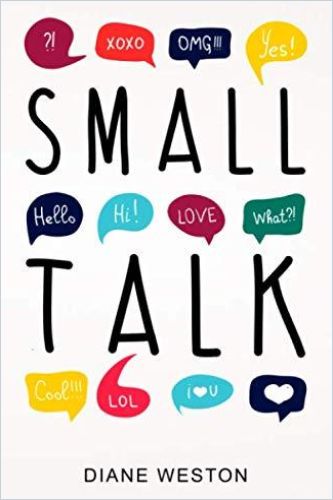Master the art of small talk by giving your complete attention to others and truly listening.

A Communicative Introvert
Diane Weston, who acknowledges that she’s an introvert, studied communication and media before specializing in public relations for a Fortune 500 company. That primary contradiction – an introvert making a career in PR – suggests Weston’s skills for helping shy and introverted people communicate more readily and comfortably. It also suggests that her writing style tends – as does PR – toward the sound bite. Happily, Weston’s compassion for her fellow introverts grants those sound bites more resonance than they might muster in the hands of less kind authors.
The key to being good at small talk is to give attention to the other person without thinking about what you’re going to say next.Diane Weston
Weston’s theme is that anyone can master the art of small talk and navigate social encounters with aplomb. She proves intermittently convincing.
Energy
Weston details how introverts’ energy originates from within and extroverts receive their energy from other people. In group settings, extroverts jump into the conversation; introverts first process their remarks. Extroverts won’t excel at small talk if they talk too much about themselves. Introverts may avoid public speaking.
More than half of communication is nonverbal, so it is very important that your facial expression, posture and tone of voice all align with the message you’re trying to communicate. Otherwise, you’ll be misunderstood.Diane Weston
Weston asks you to take note of the nonverbal messages you send. Smiling and standing with an open posture means you’re approachable. Appearing scared or nervous conveys negative emotions. Slumped posture conveys sadness, while upright posture conveys happiness. These are obvious keys, but fit well in Weston’s systematic makeover of the shy.
SOFTEN
Weston urges you to use the SOFTEN approach – smile, open your posture, forward lean, touch by shaking hands, establish eye contact and nod to illustrate that you’re paying attention. What happens to smiling, leaning forward and touching in a post-COVID environment is anybody’s guess. But standing tall and nodding work in any situation.
Five Axioms
Weston’s other book, EQ Emotional Intelligence, attempts, like this one, to teach a skill that many – erroneously, according to the author – perceive as either innate or inaccessible. In Small Talk, Weston combines communication techniques with self-help advice. She demonstrates real understanding for those whose shyness or social inabilities cripple them. She sincerely wants to help and draws on other experts to that end.
For example, Weston cites Paul Watzlawick, a psychologist and communications theorist, who coined the “five axioms of communication” to help people understand what happens in conversation. First, it’s impossible to not communicate. Even nonverbal communication communicates a message, as does the act of doing nothing. Second, every exchange contains a content and some aspect of a relationship. The speaker feels certain things toward the listener, and vice versa. Third, the nature of a relationship depends on the communication procedures the partners employ. Fourth, interactions have digital and analog attributes. Digital refers to what you say; analog describes how you say it. And, fifth, communication procedures are either symmetric or complementary. In a symmetric relationship, both partners are equal. In complementary relationships, communication partners aren’t equal, such as in a teacher-child relationship.
Listening
Weston recommends you try small talk first with a close friend or family member to gain constructive feedback. That seems more painfully embarrassing than any public encounter, but Weston is sure it will help.
[For] true listening…you need to be quiet inside, really paying attention to the other person. Listen to the words, but also pay attention to the other cues you are getting that pertain to the message that the person is actually trying to convey.Diane Weston
One of Weston’s oft-repeated and more bedrock messages is that listening is made up of more than merely being quiet and waiting your turn to speak. Hear your counterpoint’s words, make eye contact and observe nonverbal cues. Let the other person lead the conversation, but don’t remain silent or appear uninterested.
Advice
Weston moves away from science and techniques to straight-up self-help. Her guidance is not original, but it is effective. Among her suggestions: first impressions endure. Wear appropriate clothing. Avoid averting your eyes or using aloof body language. Look at someone’s eyebrows or beneath their eyes. Take a “conscious breath” by breathing in through your nose and out through your mouth. Count breaths to relax.
To start a conversation, Weston advises referring to a shared experience or opening with a sincere compliment. Don’t answer with one-word responses. Reveal information about yourself. If you overshare, you may receive dirty looks.
“ARE:” anchor, reveal and encourage
Weston codifies her ARE method for launching a conversation. Start by talking about an anchor – something you have in common with your conversation partner. Possible anchors include your location. Mention the venue, the weather, food or drink, entertainment or decorations. Reveal something about yourself, especially as it relates to your anchor. Weston insists that this strengthens the conversational bond. And finally, encourage your partner to keep talking by asking follow-up questions.
FORD: family, occupation, recreation and dreams
Weston underscores that most people like to talk about themselves or their families. Ask people what they do for fun and about future plans. Weston also guides you on how to end conversations gracefully. She reassures you that for most people, the natural decision to end a conversation is mutual.
It all comes down to treating a person right. Respect, honesty, authenticity, being genuinely interested in other people and showing kindness are all it takes to become a small talk master.Diane Weston
Weston acknowledges that sometimes you and your conversation partner just won’t mesh. She wants you to understand that this is not anyone’s fault. If your partner’s eyes glaze over, gently excuse yourself when you can.
Heartfelt
Weston returns again and again to her theme: you can learn to handle small talk, and you’ll improve as you practice. Weston’s perky, enthusiastic voice and her heartfelt belief in the methods she advocates set her advice apart from myriad books on learning to break the ice. She really seems to care about helping you break out of isolation and learn to connect. Weston writes for a specific readership: the shy. If you don’t qualify, this isn’t for you. If you do, her insights are likely to prove helpful.





